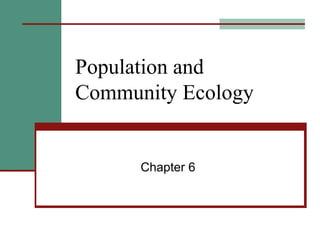
Ch 6 Population and Community Ecology.ppt
- 2. Levels of complexity Individual Population – same species, same time, same area Community – all the different populations in an area Ecosystem – all the different communities plus the abiotic factors in an area Biosphere – all areas on Earth where life exists
- 3. Population ecology Study the factors that cause population to increase and decrease Population size Input Immigration & Births Output Emigration & Deaths
- 4. Basic population characteristics Population size = total number of individuals (N) Population density = number of individuals per unit of area Helps us understand if the species is rare or abundant Population distribution = how individuals are spaced relative to others in the population Random – no pattern of location (trees in a forest) Uniform – fairly even spacing (nesting birds) Clumped – individuals gather around each other (schooling fish) Population sex ratio = the ratio of males to females Usually 50:50 Population increase is related to the number of females Population age structure = the number of individuals in each age category Populations with large numbers of young increasing Populations with large numbers of old decreasing
- 7. Factors that influence population size Density-dependent factors Influence an individual’s odds of survival in a manner that depends on the size of the population Example: available food These factors are also called limiting resources The population limit in an ecosystem is its carrying capacity
- 8. Factors that influence population size… Density-independent factors Have the same effect on an individual’s odds of survival regardless of the size of the population Example: a tornado
- 9. Population growth models Exponential growth model Growth rate = number of offspring – deaths Under ideal conditions (with unlimited resources) each species has a particular intrinsic growth rate – the max for that species This model calculates this maximum rate and displays it as a J-shaped curve (because there are no limits) Only beginning populations can actually show this type of growth
- 10. Population growth models… Logistic growth model Includes environmental limits on the population growth As the population reaches the carrying capacity, the growth slows and then stops This produces an S-shaped curve Some populations cycle above and below the carrying capacity – this is overshoot followed by die-off
- 12. Reproductive strategies K-selected species Low intrinsic growth rate Slowly reach the carrying capacity and then stay there Characteristics: Large Later maturing Few offspring Substantial parental care
- 13. Population growth models… r-Selected Species High intrinsic growth rate Rapid population growth followed by overshoots and die-offs Characteristics: Small Early maturity Small offspring Little or no parental care
- 14. Survivorship Curves Patterns of survival over time: Type I – high survival throughout most of their lifespan K-selected species: humans, elephants Type III – low survival early in life; few individuals reach adulthood r-selected species: mosquitoes, dandelions Type II – relatively constant decline in survivorship throughout their lifespan squirrels, coral
- 16. Metapopulations Smaller, fragmented parts of a larger overall population Occasionally members of one metapopulation move from one to the other This can reduce the risk of extinction: Moving individuals increase genetic diversity as well as the size of a population Human development is causing more and more metapopulations to form
- 17. Community Interactions Competition Individuals must ‘fight’ over the same limiting resource Competitive exclusion principal Two species competing for the same limiting resource cannot coexist Resource partitioning Two species divide the resource based on differences in behavior or morphology This can lead to natural selection which over time will increase the differences between the 2 species Three possibilities: 1. Temporal resource partitioning – use the same resource but at different times (coyotes and wolves) 2. Spatial resource partitioning – use different locations (plants with shallow roots vs. deep roots) 3. Morphological resource partitioning – evolution of different body plans to use different parts of the resource (Darwin’s finches)
- 19. Community Interactions… Predation - the use of one species as a resource by another Four categories: 1. True predators – kill and eat their prey 2. Herbivores – consume plants as prey; typically only eat some of the plant; rarely kill the plant 3. Parasites – live on or in a host organism; rarely causes the death of their host Pathogen – disease-causing parasite 4. Parasitoids – lay eggs inside another organism
- 20. Community Interactions… Mutualism – two species interacting in a way that increases the survivability of both Plants and the insects that pollinate them Acacia trees and ants Commensalism – one species benefits from an association with another but the other is not helped nor harmed Birds nesting in trees
- 21. Keystone Species The species on which the ecosystem stability depends – removing it leads to instability: 1. Food supply species (figs) 2. Predator-mediated competition – the predator keeps the numbers of the superior competitor in check. Without the predator, the competitor over- populates the ecosystem (sea stars) 3. Ecosystem engineers – create habitat for other species (beavers)
- 23. Changes in communities over time Ecological succession – predictable replacement of one group of species by another Two types: 1. Primary succession – occurs only on surfaces without any soil (new volcanic area; abandoned parking lot) 2. Secondary succession – occurs in disturbed areas that have not lost their soil – the original vegetation has been removed as in a forest fire or even abandoned farmland Pioneer species – plants that are able to colonize new areas at the early stages of succession. They grow rapidly and need lots of sunlight Climax community – the later stages of succession. Generally considered to be the ‘typical’ type of community for that biome
- 24. Factors affecting species richness Latitude: equator to poles number of species declines Time: longer areas have been around more species Habitat size: larger habitat area more species Distance from other habitats: increase distance fewer species